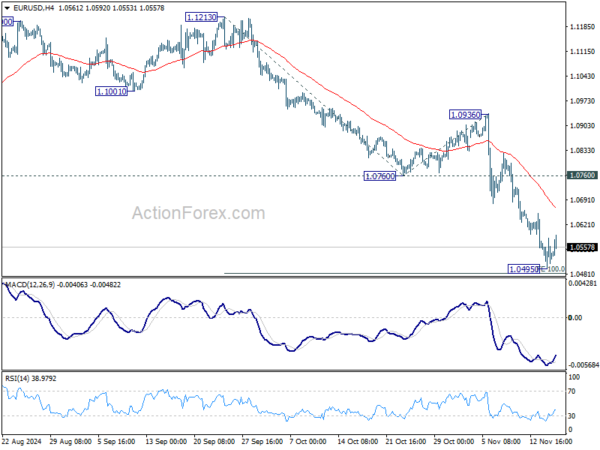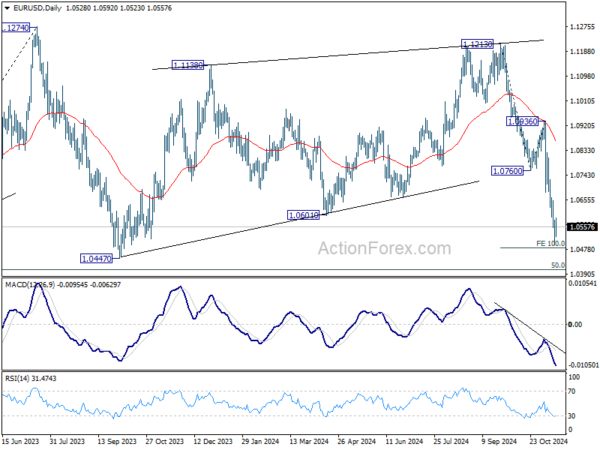Dollar is trading slightly lower as the market enters the final US session of the week, with mixed US retail sales data failing to provide fresh momentum for the greenback. The currency appears to be taking a breather as the initial impact of the “Trump Trade” begins to fade. Meanwhile, the likelihood of another rate cut next month has diminished, with futures markets pricing in around a 60% chance. This growing uncertainty adds to the Dollar’s lack of immediate direction. In the absence of new political developments, the greenback may enter a consolidation phase until early December when significant economic data releases are expected to provide new catalysts.
Despite the current softness, Dollar remains the strongest performer for the week, followed by Canadian Dollar and Euro. Japanese Yen has moved up slightly but remains the second weakest currency. British Pound has fallen to the position of the worst performer following weaker-than-expected UK GDP data released today. Australian Dollar is the third weakest, with New Zealand Dollar not far behind. Swiss Franc is trading in the middle range.
In Europe, at the time of writing, FTSE is down -0.12%. DAX is down -0.30%. CAC is down -0.36%. UK 10-year yield is down -0.0017 at 4.486. Germany 10-year yield is up 0.011 at 2.353. Earlier in Asia, Nikkei rose 0.28%. Hong Kong HSI fell -0.05%. China Shanghai SSE fell -1.45%. Singapore Strait Times rose 0.17%. Japan 10-year JGB yield rose 0.0121 to 1.075.
US retail sales rises 0.4% mom in Oct, ex-auto sales up 0.1% mom
US retails sales rose 0.4% mom to USD 718.9B in October, above expectation of 0.3% mom. However, ex-auto sales rose 0.1% mom to US 528.5B, below expectation of 0.2% mom. Ex-gasoline sales rose 0.4% mom to USD 667.1B. Ex-auto & gasoline sales rose 0.1% mom to 621.6B.
Total sales for the August through October period were up 2.3% yoy from the same period a year ago.
Fed’s Collins: December rate cut not guaranteed
Boston Fed President Susan Collins signaled in a WSJ interview that a rate cut in December is “certainly on the table. However, it remains far from being a “done deal”.
She emphasized the importance of upcoming economic data in shaping the Fed’s decision-making process, noting, “There’s more data that we will see between now and December, and we’ll have to continue to weigh what makes sense.”
Collins underlined her pragmatic approach, explaining, “I don’t see an argument for maintaining restrictive policy when there is not evidence of new price pressures.”
However, she also acknowledged that the inflationary dynamics that have persisted over the past year are “perhaps unevenly and gradually resolving over time.”
European Commission forecasts modest recovery and faster disinflation for Eurozone
The European Commission maintains its projection for Eurozone GDP growth at 0.8% in 2024, unchanged from its Spring forecast. However, it has slightly downgraded the 2025 growth projection to 1.3% from the previous 1.4% in Spring forecast, introducing a new projection of 1.6% growth in 2026. For the EU as a whole, GDP is expected to grow by 0.9% in 2024, 1.5% in 2025, and 1.6% in 2026.
Inflation is anticipated to decline significantly. In Eurozone, headline inflation is projected to more than halve from 5.4% in 2023 to 2.4% in 2024, slightly lower than the previous estimate of 2.5%. It is expected to ease further to 2.1% in 2025 and 1.9% in 2026. The EU is forecasted to see an even sharper disinflation, with headline inflation falling from 6.4% in 2023 to 2.6% in 2024, continuing to decrease to 2.4% in 2025 and 2.0% in 2026.
Executive Vice-President Valdis Dombrovskis highlighted that the EU economy is steadily recovering, with growth expected to gain momentum next year. Factors contributing to this acceleration include rising consumption driven by increased purchasing power, sustained record-low unemployment, and anticipated improvements in investment levels.
European Commissioner for Economy Paolo Gentiloni noted that as inflation continues to ease and private consumption and investment growth pick up, supported by unemployment at record lows, growth is set to gradually accelerate over the next two years.
UK GDP shrinks -0.1% mom in Sep; Q3 growth slows sharply to 0.1% qoq
UK economy contracted by -0.1% mom in September, falling short of market expectations for 0.2% mom growth. The contraction was driven largely by declines in manufacturing output and information and communication services, with monthly services output showing no growth. Meanwhile, production sector experienced a notable -0.5% drop, primarily due to a sharp decline in manufacturing. Construction output offered a slight silver lining, rising by 0.1%.
For Q3, GDP grew by a marginal 0.1% qoq, marking a steep slowdown from Q2’s 0.5% qoq growth and missing forecasts of 0.2% qoq. The services sector, which accounts for the largest share of economic activity, expanded by just 0.1%, while construction demonstrated resilience with a 0.8% increase. However, the production sector contracted by -0.2%, reflecting persistent weaknesses in the industrial base.
Japan’s real GDP growth slows to 0.9% annualized, robust consumption but weak investment
Japan’s economy expanded by 0.2% qoq in Q3 2024, aligning with market expectations but indicating a slowdown from the previous quarter’s momentum. On an annualized basis, GDP grew by 0.9%, surpassing the anticipated 0.7%, yet decelerating from a downwardly revised 2.2% growth in Q2.
The second straight quarter of expansion was largely propelled by robust private consumption, which accounts for over half of the nation’s GDP. Private consumption increased by 0.9% qoq, up from revised 0.7% in the prior quarter, driven by solid demand for automobiles and the influence of wage increases. Despite persistent high inflation, consumers are channeling funds into spending as a result of wage gains.
However, the economy faces challenges as capital investment declined by -0.2% qoq after previous growth, reflecting the impact of a global economic slowdown on sectors like chipmaking equipment. Exports inched up by 0.4% qoq, indicating some resilience in external demand. In contrast, imports surged by 2.1% qoq, which negatively affected GDP by subtracting 0.4 percentage points from growth.
China’s industrial growth and investment lag, while retail sales outperform in Oct
China’s economic data for October showed a mixed performance, with retail sales surpassing expectations while industrial production and fixed asset investment slightly underperformed.
Industrial production grew by 5.3% yoy, just shy of the expected 5.4% yoy and holding steady from the prior month. Fixed asset investment also slowed, increasing by 3.4% ytd yoy compared to the forecasted 3.5%.
Real estate investment continued to struggle, declining by -10.3% from the previous year’s level over the January-October period, marking the sharpest annualized contraction since August 2021. This steeper drop reflects ongoing pressures in China’s real estate sector.
In contrast, retail sales surged 4.8% yoy, beating expectations of 3.8% yoy and accelerating from September’s 3.2% yoy. This stronger retail activity was largely driven by a week-long national holiday and an early start to the Singles’ Day shopping festival, which boosted consumer spending.
NZ BNZ manufacturing falls to 45.8, further contraction but new orders show signs of recovery
New Zealand’s BusinessNZ Performance of Manufacturing Index dropped from 47.0 to 45.8 in, marking its lowest point since July and extending the sector’s contraction for a 20th straight month. The reading underscores continued struggles in the manufacturing sector, despite recent RBNZ rate cuts.
A breakdown of the report reveals broad weakness across production and employment indicators, with production slipping from 47.9 to 44.5, and employment declining from 46.8 to 45.8. Deliveries also fell to 44.6 from 45.6, and finished stocks modestly increased to 47.4. However, new orders provided a rare bright spot, rising from 47.9 to 49.0, the highest level since May 2023.
Encouragingly, the proportion of negative comments from respondents fell to 53.5% in October, a marked improvement from the previous months, where negative sentiment had peaked at 76.3% in June.
BNZ’s Senior Economist Doug Steel noted, “Despite lower interest rates, the manufacturing sector continues to face significant headwinds. Recent business surveys show a sharp contrast between improved expectations for activity and weak current conditions.”
EUR/USD Mid-Day Outlook
Daily Pivots: (S1) 1.0490; (P) 1.0536; (R1) 1.0576; More…
Intraday bias in EUR/USD stays neutral for consolidations above 1.0495 temporary low. But outlook will remain bearish as long as 1.0760 support turned resistance holds. On the downside, firm break of 100% projection of 1.1213 to 1.0760 from 1.0936 at 1.0483 will target 1.0404 key fibonacci level next.
In the bigger picture, price actions from 1.1274 (2023 high) are seen as a consolidation pattern to up trend from 0.9534 (2022 low), with fall from 1.1213 as the third leg. Downside should be contained by 50% retracement of 0.9534 (2022 low) to 1.1274 at 1.0404, to bring up trend resumption at a later stage.


